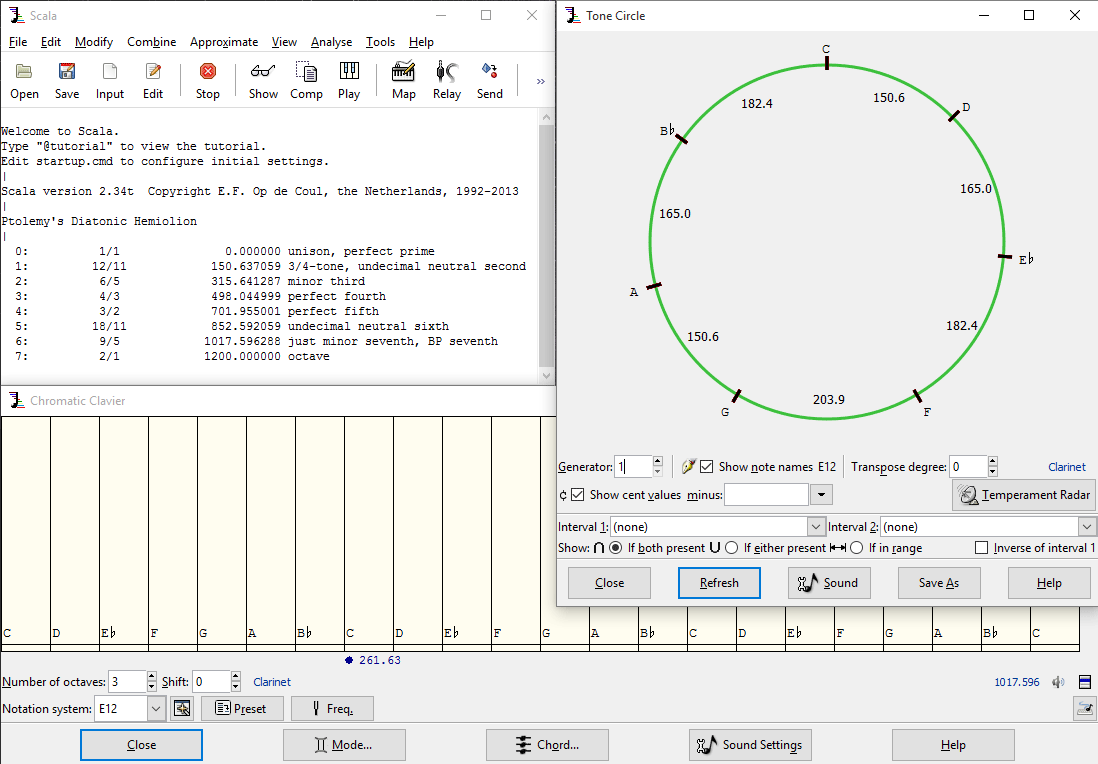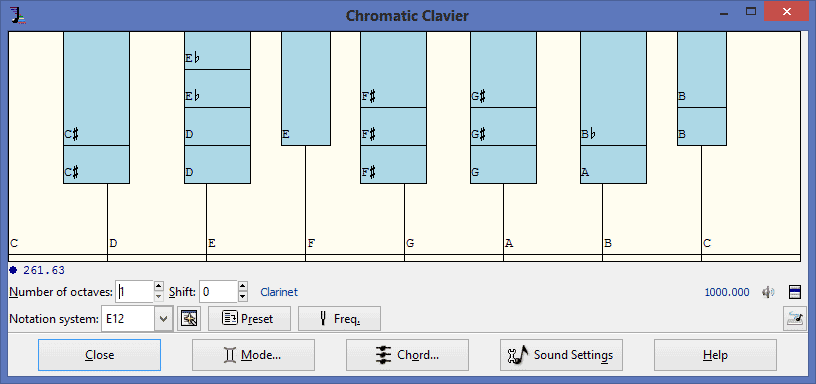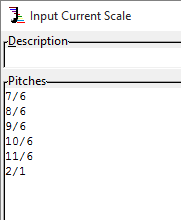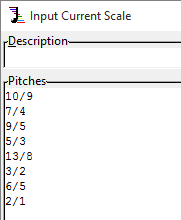You are browsing the Microtonal/Xenharmonic category
This is my answer to the question “Sevish, how do you make your music?”
I won’t discuss my creative process but I’ll explain my workflow and the tools used to get music made. What I like about my workflow is that it works superbly for me.
I use Ableton Live to write, record, and mix my music. Within Live, I load VST instruments that have built-in microtonal scale support. I use Scala to produce the tuning files necessary to retune those VSTis. I play the VSTis using my MIDI keyboard, C-Thru AXiS-49, QWERTY keyboard and through mouse input. I also sample recordings that I have made using my Zoom H4n portable recorder.
Ableton Live is a DAW (digital audio workstation) that has an effective workflow for electronic music. For my drum’n’bass, breakbeat electronic, it works just fine. Live has no built-in microtonal scale support, and the piano roll is always locked to a 12-note Halberstadt layout, which can be tricky.
It’s possible to make microtonal music in Ableton Live by using VST instruments or Max 4 Live instruments with microtuning support built in. As far as Ableton knows, MIDI data goes into these instruments and audio comes out. It’s up to the instruments themselves to provide the new tunings and scales that I use in my music.
I use a couple of Max 4 Live instruments that I made myself, plus several VSTi: Xen-Arts FMTS2, IVOR, XenFont, TAL-Sampler, u-he ACE and Garritan Personal Orchestra 4. All of these plugins have full keyboard tuning support, which is why I choose to use them. To tune up, they each require you to import a tuning file. I’ll elaborate on that later.
Before writing a piece, it works well to have an idea already of the tuning you want to use. Scala can be used to invent musical tunings or specify an old one. I have written about how to invent your own scales with Scala, described other superbly expressive tunings that already exist, and hand-selected some interesting scales to download.
Once I have a scale in Scala that bends my ear in just the right way, it must be exported as a tuning file for it to be usable in those VST instruments. The common formats are:
I wrote a guide to exporting .tun files, and the process is much the same for producing MIDI tuning dumps and .txt tuning files.
(If you’re a Max/MSP or Max 4 Live user, I also wrote a guide to microtuning your patches with the coll object, and microtuning using expr).
After I have some tuning files to work with I’ll load them up in one of my synths, and jam away until I play something I really like. I don’t go too deep in to the theory of it all; I leave that up to others. Using your ear and finding sounds you like is a good way to go.
I like to record sounds on location with my H4n portable recorder. After recording I keep the audio in my personal sound library until I’m ready to use them in a project.
I almost never use the preset sounds on my synths. It’s best to patch in your own sound designs because that becomes a recognisable part of your craft. It’s well worth practicing this skill for yourself. Some days I do nothing but come up with new sound designs with my fave synths. That way I can save them in my personal library and use them only when inspiration strikes.
The AXiS-49 is a hexagonal keyboard controller, and it’s best suited to exploring microtonal scales because it makes fingering really easy. Imagine trying to play a 15-note scale on a standard keyboard where the pattern repeats after every 12 notes… The fingering gets totally perplexing and that gets in the way of creativity. With the AXiS that’s no problem at all. The AXiS also greatly increases my reach, so I can play large chords easily.
The difficulty I find with the AXiS is that I use so many different tunings that it’s difficult to build up a muscle memory for any of them. And the buttons are so close together that I make mistakes quite easily.
It comes in handy to have a standard keyboard at times. I was given a 2 octave MIDI controller with some knobs on it which I can map to various functions in my DAW. Using this to recording automation in real-time is one way to breathe some life into a static synthesised part.
I mix and master in Ableton Live, then publish on my Bandcamp, YouTube and Soundcloud pages. Which you should definitely check out.
I was recently interviewed by UnTwelve’s Aaron Krister Johnson and our conversation was published on their website today. We talked about the making microtonal music accessible to general audiences, the split-notes label, gear, composition and tuning.
Ever had that musical crisis where you realise there are only 12 notes in music, and only so many combinations to use them? That crisis that nothing is original anymore and everything you have written has already been written?
Yeah we all get that at some point. It goes away when you learn that there are more than 12 notes in an octave.
These 9 tunings are for experimenters who want to push the boundaries of their own music. These aren’t necessarily the 9 best tunings ever, since there’s no such thing. (By all means, if you disagree then share your favourite tunings in the comments!)
Oh and by the way, the title of this post was a clever ruse; you can use these tunings on the guitar if you’re willing to pull out the frets and rearrange them differently on the fretboard. Check out Steven James Taylor, Jute Gyte, Cryptic Ruse, MonoNeon (on bass), Paul Erlich, ilevens, Dave Fiuczynski, Jon Catler, Microtonal Guitar Duo…
Now that you know we’re talking about real alternative tunings and not DADGAD, let’s begin…
If I had to stick with one scale for the rest of my life, it would be 22-edo. It has such a variety of sounds from the familiar to the xenharmonic. It also sounds amazing for solo piano music. What’s most interesting is that the familiar sounds (for example major and minor chords) don’t connect to each other in the same way, such that chord progressions necessarily make surprising turns while the individual chords aren’t necessarily xenharmonic.
You could also treat 22-edo as a superpyth temperament, so that it has a diatonic scale just like 12-edo but with one important difference – the major thirds are much sharper and the minor thirds are much flatter. So if you like jangly sounds, this is it right here. Oh and interestingly, the A# turns out to be sharper than the Bb, which betrays the intuition of today’s 12-tone musicians who would think of them as the same note.
Pajara temperament is another lens from which to view 22-edo. Paul Erlich wrote a fascinating paper on the decatonic (10-note) modes of 22-edo which relate to pajara. These decatonic scales are sometimes symmetrical around the tritone, and they use the harmonic 7th (think of a barbershop 7th ringing chord) as an essential part of the harmony. In fact, Paul’s decatonic modes see the tonic chord as a tetrad (4-note chord) instead of the usual triad. So it’s like music++.
Porcupine temperament (yes, these are all real and understood names used by tuning theorists) is yet another new tonality that can be accessed via 22-edo. In porcupine’s case, you can play a 7-note scale scale that contains 2 major triads and 2 minor triads, and these triads can also include the 11th harmonic (a fourth that’s a quarter-tone sharp, sounds amazing).
You can’t get much more ‘alternative’ than this: let’s do away with the octave altogether and make a scale that repeats at the perfect twelfth (aka tritave). Then let’s fill the scale with ratios that only contain odd numbers.
Of course I’m talking about the Bohlen-Pierce scale, discovered independently by at least 2 different people.
You can even make a temperament of the Bohlen-Pierce scale by dividing the tritave into 13 equal parts. It sounds really good too, but not in the traditional sense at all. It sounds good in an alien yet harmonious, future-tonality kind of way. Continue reading
Next Xen, a compilation album of music using alternative tunings, has just been released on the split-notes label!
The album features myself (Sevish), Banaphshu with Kraig Grady, Brendan Byrnes (ft. Louis Lopez), Carlos Devizia, Tony Dubshot, Jacky Ligon, Miekko, John Moriarty, Mosstone, Steve Mueske, Mythshifter, Robin Perry, Joseph Post, Carlo Serafini, Tall Kite, Elaine Walker, and Ozan Yarman (Ph.D.)
This free album is a snapshot of the online microtonal music community at the start of 2016 and shows a variety of approaches to groove-based microtonal/xenharmonic music. Check out the included liner notes to find out more about each artist and their approach to microtonality. If this is your first experience with microtonal music, then listen well and welcome to the madness!!
17 microtonal musicians come together to make an album of tasty xenharmonic beats. Make sure you download this one from split-notes.com when it arrives on February 6th.
I was reading some of Ivor Darreg’s writings and a really interesting idea jumped out.
“Try this: Move the bridge down until the 13th (instead of the 12th) fret sounds the octave of the open string. This will give an approximation of the 13-tone equal temperament.”
Here’s how it works. If you have a guitar with a movable bridge, then you can move it down such that the 13th fret gives you a perfect octave. This gives you a 13 tone scale to play on your guitar!
While its approximation to 13-edo is far from perfect (you’d need to completely move the frets for that) this should offer plenty of new tonal resources to the experimenting microtonal guitarist. Compared to 13-edo, the error is largest in the middle of the scale.
You can reverse this and push the bridge up such that the octave lies on the 11th fret, giving you a brand new 11-tone scale to experiment with. Again, it poorly approximates 11-edo but don’t worry about that, there are plenty of new sounds available through this method.
The idea can be pushed further:
“I fretted a guitar to 18-tone (Busoni’s proposed third-tones) and can use this guitar as a 17 or a 19 without the theoretical errors from moving the bridge spoiling any performances. So you can have three systems for the price of one.”
This really is “one weird trick that luthiers don’t want you to know!” Bwaha… ok I’ll see myself out the door.
For something a little different, check out 9 Alternative Tunings NOT for Guitar.
An example of a microtonal chord progression in 22edo (22 equal divisions of the octave, aka 22-tone equal temperament). These harmonies would be impossible to reproduce accurately using standard Western tuning, Arabic intonation, or basically any other traditional intonation. But with the new intonation systems that are popular within the xenharmonic scene, you might hear something new.
The tempo and velocity is controlled by a drunk walk using the drunk object in Max/MSP (Max 4 Live). Sound designs using Xen-Arts IVOR and FMTS2.
I’ve been following Dolores Catherino’s beautiful microtonal music for quite a while and it’s fascinating to get a look into her musical space. Everybody has a different approach to microtonality and hers is certainly different to mine. There are some very cool pieces of kit on display, like the Starr Labs Microzone U-648, H-Pi Tonal Plexus, Haken Continuum Fingerboard, and ROLI Seaboard.
This video also serves as a very inspiring introduction to why one would start using microtonal scales to push music into the future.
She also mentions that we could extend frequencies up above and beyond the range of human hearing (i.e. above 20kHz) with future advancements in sample rate fidelity and loudspeaker design. While it remains to be seen if this would have an effect on our perception of the music, it’s very interesting food for thought.
[Update Jan 2023: This article is quite old now. If you’re looking for something more user-friendly than Scala, try Scale Workshop. If you want to learn more about Scala, read on!]
When you want to edit photos, there’s Photoshop. When you want to listen to music there’s iTunes (if you’re a pro at life, there’s foobar2000). When you want to create your own musical scales, opening up endless possibility in harmonic and melodic expression, there is Scala. Scala is a multi-purpose toolkit for everything related to tunings, scales and microtonality. You have a hardware synth that you want to retune? Scala will do it. Or a softsynth? Scala can export the tuning files required to make that happen. Want to generate all kinds of crazy scales that you can use to compose new music? Scala has near infinite options for you to play with. Want to experiment with world music and historical scales? There’s a database of thousands on the Scala website.
Equal temperaments are scales that divide an octave into some number of equally big pieces. The 12 note scale of Western music is an example, as each semitone is of equal size. So you already have experience with equal temperament scales and didn’t know it.In Scala, equal temperaments are trivially easy to create!A popular thing that beginning microtonalists like to do is to try quarter tones. The quarter tone scale divides the octave into 24 notes. Let’s make the scale in Scala. Load up Scala, type this line into the text field at the bottom, then hit enter:
equal 24
Explanation: When you type the command equal, followed by a number, Scala will produce an equal-tempered scale with that number of notes in an octave.But it looks like nothing happened after we hit enter. We still need to check that the scale was created correctly. So type:
show
This will show you the tuning data for the equal temperament scale you just created. As below:
0: 1/1 0.000000 unison, perfect prime 1: 50.000 cents 50.000000 2: 100.000 cents 100.000000 3: 150.000 cents 150.000000 4: 200.000 cents 200.000000 5: 250.000 cents 250.000000 6: 300.000 cents 300.000000 7: 350.000 cents 350.000000 8: 400.000 cents 400.000000 9: 450.000 cents 450.000000 10: 500.000 cents 500.000000 11: 550.000 cents 550.000000 12: 600.000 cents 600.000000 13: 650.000 cents 650.000000 14: 700.000 cents 700.000000 15: 750.000 cents 750.000000 16: 800.000 cents 800.000000 17: 850.000 cents 850.000000 18: 900.000 cents 900.000000 19: 950.000 cents 950.000000 20: 1000.000 cents 1000.000000 21: 1050.000 cents 1050.000000 22: 1100.000 cents 1100.000000 23: 1150.000 cents 1150.000000 24: 2/1 1200.000000 octave
Explanation: The equal command that we just used has produced 24 items for us (24 notes in our scale). The show command lets us see those 24. Each of these shows some number of “cents.” The cent is a measurement of how wide or narrow an interval is. Notice that each interval in our 24-equal scale goes up by 50 cents. 50 cents is exactly one quarter tone. 100 cents makes up a semitone, and 1200 the whole octave. Cents are a useful measurement to get your head around if you want to compare tunings with each other.That’s enough staring at numbers. Time to hear these quarter tones for the first time. On the Scala interface you’ll see a button which says play. Click that button!
In the first part, we divided an octave into some number of equal parts. Amazingly, we are not limited to dividing octaves. We can choose to divide other intervals instead, such as a perfect fifth or whatever you like. But what’s the point?Every note in a non-octave scale has a unique identity. Consider that we know a note A as a note oscillating at 440 Hz, or some octave above (880 Hz, 1760 Hz) or below (220 Hz, 110 Hz, 55 Hz). If our scale doesn’t include octaves, then a note A won’t have any other counterparts higher or lower in the scale. This means that, as we climb up or down into different registers, we keep hitting unique note identities which haven’t been heard elsewhere in the scale!This approach is extremely fruitful for new sounds, sonorities and progressions. However composition technique must change drastically. For starters, there are no more chord inversions, since you can’t raise any notes up or down an octave. Of course, this makes voicing difficult too. But you gain a very wide variety of intervals to play with, and it will challenge and grow you as a composer to exploit non-octave scales. Just try it and see.Here’s how we do it. We’re going to create a scale which divides a perfect twelfth (an octave plus a fifth) into 13 equally spaced parts.
equal 13 3/1
Explanation: The equal command tells Scala that we’ll be making a scale where all notes are the same size. The number 13 shows that we want 13 notes. And that weird fraction on the end? That’s the big interval that will be split into 13 equal parts. Think of it as a pseudo-octave.Why 3/1? For now just take my word for it. 3/1 is a perfect twelfth. So rather than repeating at the 8th (octave), we’re repeating at the twelfth.Notice, if we don’t include the number 3/1, then Scala will assume that this is an octave based scale. (An octave, by the way, can be expressed as 2/1).Let’s see the cents values for the scale we created:
show
And the result:
0: 1/1 0.000000 unison, perfect prime 1: 146.304 cents 146.304231 2: 292.608 cents 292.608462 3: 438.913 cents 438.912693 4: 585.217 cents 585.216923 5: 731.521 cents 731.521154 6: 877.825 cents 877.825385 7: 1024.130 cents 1024.129616 8: 1170.434 cents 1170.433847 9: 1316.738 cents 1316.738078 10: 1463.042 cents 1463.042308 11: 1609.347 cents 1609.346539 12: 1755.651 cents 1755.650770 13: 3/1 1901.955001 perfect 12th
Can you remember how many cents are in an octave?The answer is 1200 cents. Looking at the above list of intervals, we can see there’s no value too close to 1200 cents at all. But there’s this nasty 1170 cents interval that’s gonna sound noticeably flatter than an octave. On the other hand, that perfect twelfth at 1901.955 cents, is purely in tune. Whatever this scale is, it doesn’t represent anything we’re used to in Western music. There’s no perfect fifth, no octave…The scale we’ve just created is none other than the Bohlen-Pierce scale, a famous non-octave scale with many interesting properties. It sounds very alien until you have taken time to immerse yourself in it. Jam with the chromatic clavier and hear it for yourself (remember, just click the play button on the Scala interface to do this).
The topic of just intonation (JI) is deserving of several books in its own right. It is an old mathemusical theory in which many cultures have their own take.What could a name like “just intonation” mean… If you think of “just” as meaning fair, right, exact, and perfect – and intonation of course having to do with the accuracy and flavour of the pitch – then you should get the general idea. Just intonation is a tuning system that uses exact, perfect intervals.In fact, the pitches of just intonation are made up of ratios. Think of numbers such as 2/1, 3/2, or 15/8. (These intervals are an octave, perfect fifth and major seventh, respectively).
Time to get creative! There are many ways to go about making your own just scale, but here’s one way that can get you exploring quickly.On the main Scala window, click on the Input button to open up the Input Current Scale window. Here you can enter the pitches you want to use. In this case we’ll enter some fractions at random, following some simple guidelines.
Below are a few examples that follow the above guidelines.


You can also use Kyle Gann’s anatomy of an octave to find some interesting numbers to plug in.Once you’re done, hit OK and you’ll be taken back to the main Scala window. At this point you will find 9 times out of 10 that Scala says “Scale is not monotonic ascending.” If you saw this message then it means that the pitches of your scale are in a weird order. To fix this issue, tap the Edit button on the main Scala window, tap the Ascending button, and finally click OK.Let’s take a quick look at what you made:
show
Take a quick look at the interesting names that Scala gives to the ratios you randomly chose.Now it’s time to hear your scale! Hit the Play button to show the Chromatic Clavier. You can hold shift when you click to hold multiple notes down and hear that solid JI sound.Alternatively you can play your scale using a connected MIDI controller or MIDI keyboard. To do this just click the Relay button on Scala’s main window and then click the Start Relaying button.Repeat this process of JI scale creation a few times, each time playing your scale using a keyboard to get a feel for the unique musicality of each one.Once you become comfortable with this process and you get to know certain ratios that you love the sound of then you can start to ignore the guidelines I gave before.
Now you know how to come up with a just intonation scale of your own. But you still might not know why you would want to use just intonation. There are many differing opinions out there and it’s easy to find them using Google. And I recommend you spend a lazy afternoon doing just that. Here are a few suggestions: